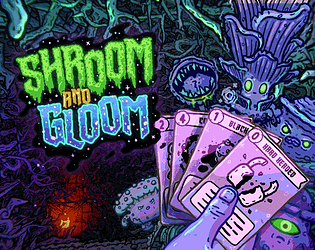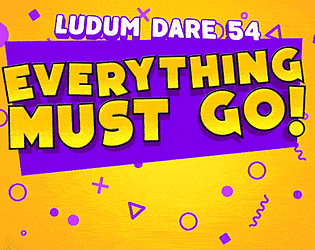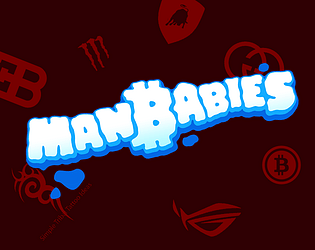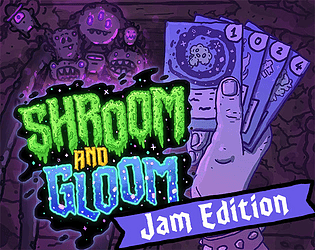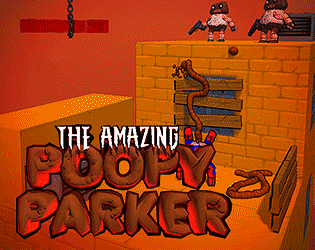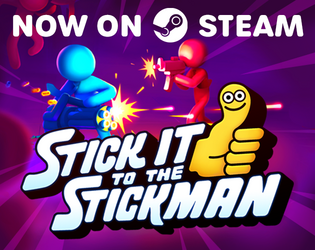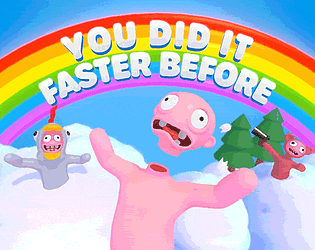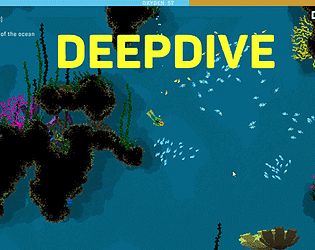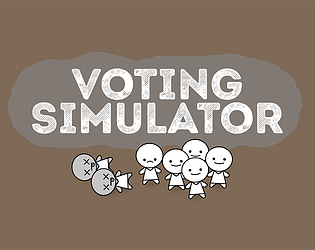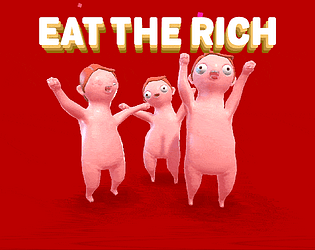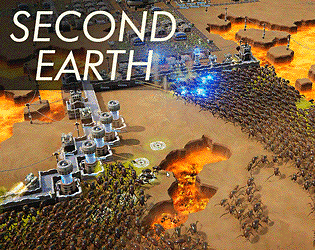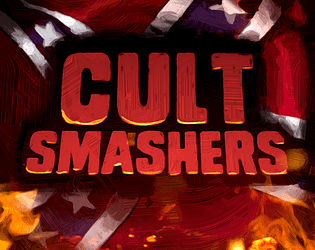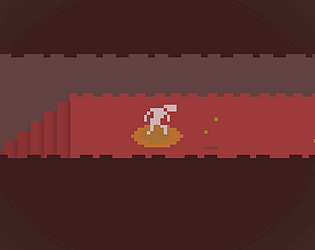This Giga Omega Yoke implosion is almost better than just being huge. It’s like going into scientific notation in Balatro. The flames on the Balatro numbers. I love the instability.
Call Of The Void
Creator of
Recent community posts
This is a very cool puzzle design.
I think a thing that might improve the game is displaying which power lines are charged (and in which direction)... Currently, in order to figure out the direction of a circuit the player has to trace forwards from the last switch, and it isn't always super clear how the power lines are connected (there are some obfuscated T-Junctions in places that I'm still not sure how the connection worked, but I beat it via trial and error).
It's a solid challenge though, it gets complicated pretty quickly. It's a pretty excellent puzzle game to have made within the few days of the game jam!
Love the concept and the vibe! Super cool Americana feeling.
I struggled a bit with the rules. Once I missed a single checkpoint I was sort of stuck racing without progressing at all. So then I started driving really slowly to help keep between the checkpoints. The risk of missing a checkpoint, given the wide turning circle, was too great.
The check points also don't follow the road, which means I had no idea where the next checkpoint will be, so I couldn't go fast because the checkpoint might require me to take a corner sharply.
I think I could really love this game if the level design helped me feel like a badass. It's such a cool theme for a racing game!
Thanks!
I'm not 100% certain about the "Amen" part... the concept was a little bit like "Assemble your troops and then pray"... a bit like in Balatro where you just hope your number is high enough.
I'm sure glad you could figure it out! (Given that it is pretty untested and clearly a bit confusing!)
I think 68,000 is higher than I've ever gotten!
Neat idea! It was fun, though the feedback on what was causing me not to be able to braai felt missing. There was no feedback on which item was causing the braai to fail. (I did read the instructions, but I wasn't certain what constituted the middle of the braai...)
Full disclosure, I'm not very good at braaing in real life.
This is a very compelling game until the content ran out. It took me a minute to figure out what caused death, and like others have said, more enemy variety would be the next thing to work on (and Shogun Showdown has lots of ideas for this).
But I really enjoyed it! I played to the end. The strategy involved in making blocks land in the best possible placement is interesting! (I would have loved some push back and swap positions attacks to play with)
The first two levels were good... the puzzles worked well and introduced the mechanics... the visuals were clear and easy to parse...
But the third level (the platforming one) was kind of a pain. Pushing blocks with your face is kind of a pain, and first-person platforming is kind of a pain (if there aren't parkour mechanics). I'm surprised my solution of pushing the two blocks on top of each other worked, it felt like if anything went wrong I'd have to restart the level again. Is that level necessary?
I'm curious about where the final level is heading, with the enemies who target you. I'd like to see it all come together. I'd like to use an enemy corpse to activate a button... but then... I suspect the gun isn't ever going to work.
Haha! There's so much potential here. I wanted the boulders to be better at killing the gummies, I guess setup so that they roll towards the gummies rather than across their path. The level being a bit tighter might have allowed for this.
I'd also like a bit more hit-stun on the gummies. It felt like they could jiggle more in reaction to being shot (though the fact that they did jiggle was pretty satisfying)
This feels like a really solid concept! Splatoon meets Need For Speed.
It's already been said, but a smaller map would probably make it better. In a multiplayer game you don't want players going off and doing their thing alone. Multiplayer is best when interacting with other players. And in a smaller map the players will naturally spend more time bumping into each other and going over each others' tracks. The size of the current map feels like you could each have your own single player adventure separately (which isn't great).
I haven't played it properly in 2 player yet. But I feel like there's an obvious mechanic when it comes to bumping cars:
The opponent's car should not explode, instead it should spin away, out of control, leaving behind a trail in your color.
Another thing, that has been mentioned. There should be a way to get nitro back... perhaps skidding slowly replenishes nitro? (I guess it's that, or over-time, or pickups). Hmmm... Are those blue capsulte pickups?
I don't play many driving games, but I enjoyed the extra-arcady feel while I had Nitro. Felt like I had more control than in a normal driving game (and the Nitro made it much easier to keep a skid going, which felt fun).
Getting stuck upside down after ramping was less fun :P
Super glad that you're not demoralized. Your game is still technically very impressive, and maybe could have been great if you had had three weeks on it, but it's clear (like you say) that you didn't get time to do anything else other than "get everything in".
I don't think adding a third person to the team will help.
Expanding the team means more communication, more time spent getting everyone onto the same page and excited. The team will grow by 50% but the work you'll be able to do might increase by 25%... and you'll probably try be even more ambitious now that you have a third teammate (assuming nothing else changes).
I feel pretty confident it will play out that way, that you'll just be more ambitious with three people, because Twin Hydra seem to have a little bit of time blindness, and a lot of enthusiasm for new features.
I too have a lot of enthusiasm for adding more things into a game. At Free Lives I'm probably the person who is most inclined to over scope and just keep adding more. I don't think it's a harmful impulse when harnessed for good, but it can lead to disappointment and sorrow when used for evil (in my experience).
Maybe if you split up, each working on their own game, you'd find you are both less ambitious and so work more within your means, and maybe you'll have better outcomes...
But that seems sort of sad. And honestly I think you're just going to run into this problem at a later stage anyway.
Here's my advice... get your salt pinching fingers ready... I do a couple things these days that help me avoid overscoping:
A) I attach times to tasks. If the task says "implement a new major mechanic", for example movement, it's a day of work in a jam. This includes testing and iteration of course. If the thing needs to interact and actually feel good - it takes a day, if it can be janky then if can be a bit quicker.
Critically: the time a task takes isn't the raw implementation time, the time a single task takes includes all the iterations and time spent talking about how to fix it or improve it. Don't even try predict it, just mark it down as a day.
This means I can do two or maybe three mechanics in a jam, and I have to make the game enjoyable with just those. And I'm pretty damn fast at jamming.
For instance the robot movement is a day, the camera system is a day, puzzles in the robot space is a day, the moving from in world to computer screen is maybe half a day, the Clippy system is half a day, the carrying around a robot in FPS view is a day. The megazord fusion is a day. Some sort of doomsday ending is a day.
i.e. I know before I've started that I couldn't have made the game you were trying to make in a jam. So, hopefully, I wouldn't have tried.
B) I don't move on from a task until it is tested and it is good (and it is tested again).
If moving a robot around is bad or untested, I won't start with movement/camera puzzles, if the puzzles at the robot level are bad or untested, I won't build the FPS part where you drop the robot in the hole, if the FPS part is bad or untested I won't build the fake Windows interface... and so on.
Generally in a jam I'm then designing games that have multiple exit points. Like if I'm running out of time it will still be good if it is just X, but if things go well we can do X and Y.
i.e. My plan is always start small and expand in layers like an onion.
This obviously has some drawbacks... mostly that it makes it hard to write a narrative, literally not knowing what the game will do at the end of the jam, so I will start off with a vague idea of stories the game could tell are, and only fill in those details when the game has the elements to tell those stories. It's a compromise of course, but I think it's generally better than trying to tell the whole story despite the game not supporting that story.
Beyond narrative difficulties, in general this iterative approach means you cannot plan the entire game at the start. At best you can have a theory of what the game could be, but there will be a ton of "if this is fun" or "if we implement this really well". I'll have a plan B in case the ambitious elements need to be cut, and most often I am forced to fall back to a plan B, or plan C or D... but that's generally because plan A couldn't have been implemented well in the time.
The HUGE upside about working iteratively instead of sticking to a plan is that making games just isn't predictable. Sometimes one seemingly small feature turns out to be a massive challenge requiring a lot of iteration, sometimes the feature turns out to straight-up suck, and then the shape of the whole game needs to change because you actually only have half the time you'd expected to do the rest. Since this ALWAYS happens, in my mind it's better not to plan in detail in the first place because it makes it emotionally more challenging to pivot later.
Those are my thoughts.
A) Allocate realistic time for tasks when you are planning.
B) Don't plan, work incrementally and iteratively.
This is really impressive technically. And I can see the shape of the puzzle, though I gave up at the yellow truck.
If I can be honest, I feel like this is a pattern with Twin Hydra game jam games. Twin Hydra games have a lot of content in them, but the content is frustrating to wade through.
I'd love to see Twin Hydra do a small game well instead of a big game badly. My concern is that the skills needed to make an experience enjoyable aren't been practiced in these games... each game has a different janky movement scheme... lots of unique but once off simple puzzles that players briefly encounter with no room for mastering. In layman's terms: "This isn't fun."
I applaud the innovation and the creativity and the technical competence... but I worry about this pattern I'm seeing. I only worry about it because it seems to me Twin Hydra are incredibly talented, but are going about development ass-backwards. Nothing feels iterated or playtested, it all just feels ticked-off.
I'd be happy to explain further. I'm not sure if I'm being clear here. My critique isn't aimed at the game itself, but rather what I perceive/expect to be the process behind the game, and other recent Twin Hydra games.
Haha! Having the "W" to move forward (rather than a click) was the closest we came to having an argument during the jam. I think we could probably include an option for people who want to play single-handed, but there was something about pressing forward that felt a little more visceral.
We're not big fans of puzzle games, so I think our natural instinct is towards more headroom, more viable strategies.
That said, the thing that bothers me most about more headroom designs, and is mentioned in that pretty excellent article, is that players will repeat themselves given the chance, and this is boring. You mentioned headroom in the context of farming strategies in Shroom and Gloom, which is something specifically mentioned in the article, though the solution the author found probably won't save players from their min-maxing instincts in Shroom and Gloom.
Sorry if this is turning into a bit of a long response, I'm just interested in thinking about aethetics-of-dynamics in deckbuilders.
Despite some divergences, Shroom and Gloom is a "Slay The Spire-like" (which is a genre these days, one that I'd prefer to call a "Dream Quest-like" but that game never got popular). And in terms of the headroom dynamic, these games have a lot going for them. As in, they avert some of the problems of too much headroom simply by not giving many options (in Slay The Spire-likes the first choices are all "Choose One Of Three"). (in this way Slay The Spire-likes are quite different to traditional Roguelikes).
Alex Smith (the author of that headroom article) would argue that limited card choices steers players due to the low headroom in subsequent choices, that the player has to commit to a path once they've chosen it. He'd be right... but there's still something curious about simply not giving players most of the choices in the game. i.e. it's possible to make a game with relatively high headroom, but low repetition just by having a lot of content that doesn't appear every run. Like simply not offering any cards that allow farming is an actual solution, even if these cards exist in the game and do appear sometimes.
And the thing about CCG's in general, is that the random-draw-from-a-deck is naturally great at getting players to improvise (which is the opposite of the feeling Alex Smith identifies as being caused by too much headroom, i.e. Players deciding on a strategy early on and then just sticking to it). I feel like there's got to be a way to disrupt a farming strategy through introducing more randomness, like if the first half of a run involves a lot of farming, but then some event takes place half way that provides an even better approach, that would reduce the overall repetition, and as I see it the repetition itself is the problem.
All of this is to say, that I feel like Shroom of Gloom is in a good place with its headroom... but there's consequences of our highish-headroom approach that you've pointed out that I'd like to avoid - like repetitive farming, and low improvisation decks (that have few cards, and so more repetition when playing).
And I desperately don't want to reduce the headroom to solve this by direct nerfing of options (which is the low headroom approach), while I also desperately want to limit the boring strategies.
What's left then are largely content-based solutions. As in, solutions that involve more content that introduce new incentives for players or otherwise force players to improvise around a new element. And I suspect in a high-headroom design paradign content is usually the tool that solves problems.
You've already mentioned some approaches with limiting farming, like new enemies that gain in power. My feeling is, whatever these limits are they need to be baked into the rules of the base game, rather than specific encounters. For instance: all basic enemies can flee (after a turn or two) when they're feeling doomed, but then come back in a later fight. The same amount of killing enemies for "If Fatal" improvements might happen, but it would be less possible to ignore enemies and keep buffing your cards (which isn't a fun strategy).
The sound design is really excellent. That death sound, and the heaving effort sounds of the jumping blocks, it conveys a lot about this world without the need for graphics.
In the gifs it appears like it is possible to move around, though with a mouse control-scheme I'm not sure that is possible.
It also appears like it is occasionally slow motion, which wasn't what I experienced in the game. I feel like I might have been playing a gimped version of this?
I did start getting reasonably good at curving the bullets... not good enough to hit something more than 1 time out of 10, and the punishment for missing was often the bullet flying back and insta-killing me. The feeling of mastering the mechanic was there, but I got a strong sense of it being developer-hard (or somehow a gimped experience).
I couldn't figure out what to do on the third level with the turret. It's very unclear to me what I should be attempting. The two jumping blocks on the second level gave a lot of feedback, and the more I played that level the better I got at it (I restarted the game a few times, and got to the point where I could reliably beat the second level without dying).
Still, like others have said, the dream of an FPS with curving bullet-trick-shots is very appealing, and there's moments where this feels like it is realizing that dream.
Sorry if this is largely useless feedback in the case that I was doing something ass-backward all along.
Wow! Thanks for the all feedback. We haven't had a lot of outside feedback so far, so this is very valuable.
We'll have to do something about all the potential farming. It's nice to hear you're getting powerful cards, but we don't want players sitting grinding turn after turn on low level mobs.
I think all the points you raise are very salient. Buffing the campfire seems sensible. Maybe making thinning the deck a bit more expensive/complicated. I'm a fan of creating monster combos in card games, but the combos in Shroom and Gloom don't involve much investment or specialization. Though I think some of that will come naturally with more content (or at least, with more content we'll be able to design more complicated card relationships).
You sound like an expert on card games (moreso than us). I'm going to be borrowing some of your lingo and ways of reasoning about card games!
I kind of loved that the upgrades could make it difficult to get other upgrades (like getting explosions meant that I might clear my own upgrade slots by accident). It might have been a little too chaotic in this regard, and that would have bothered me in a serious game, but it was still a novel interaction that was surprising and fun.
I guess I loved that there was a commitment to using the arrows as the main means of interaction.
The kind of joke that I would personally find awesome would be arrow-based interactions that become absurd with more arrows or exploding arrows... like a William-Tell-Shoot-An-Apple-Off-My-Child random shop... where you get something if you can hit the apple and not kill the child.
The upgrades themselves felt like they resulted in some very satisfying strategies! Really impressive to have acheieved this in a jam!
If you spent longer on this, I think the area that has the most room for improvement is the enemy design and the level design. But for a jam it works super well!




